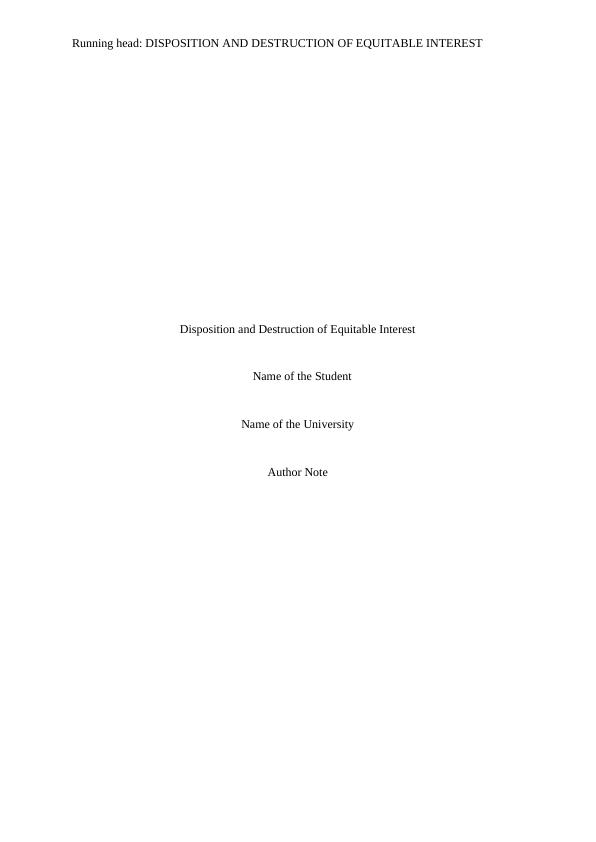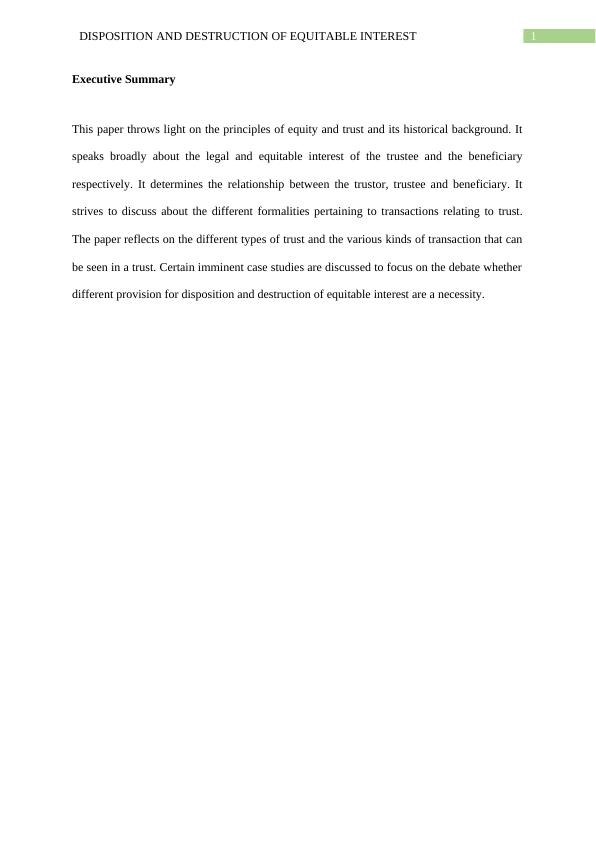Disposition and Destruction of Equitable Interest
Added on 2023-06-08
15 Pages3956 Words470 Views
Running head: DISPOSITION AND DESTRUCTION OF EQUITABLE INTEREST
Disposition and Destruction of Equitable Interest
Name of the Student
Name of the University
Author Note
Disposition and Destruction of Equitable Interest
Name of the Student
Name of the University
Author Note

1DISPOSITION AND DESTRUCTION OF EQUITABLE INTEREST
Executive Summary
This paper throws light on the principles of equity and trust and its historical background. It
speaks broadly about the legal and equitable interest of the trustee and the beneficiary
respectively. It determines the relationship between the trustor, trustee and beneficiary. It
strives to discuss about the different formalities pertaining to transactions relating to trust.
The paper reflects on the different types of trust and the various kinds of transaction that can
be seen in a trust. Certain imminent case studies are discussed to focus on the debate whether
different provision for disposition and destruction of equitable interest are a necessity.
Executive Summary
This paper throws light on the principles of equity and trust and its historical background. It
speaks broadly about the legal and equitable interest of the trustee and the beneficiary
respectively. It determines the relationship between the trustor, trustee and beneficiary. It
strives to discuss about the different formalities pertaining to transactions relating to trust.
The paper reflects on the different types of trust and the various kinds of transaction that can
be seen in a trust. Certain imminent case studies are discussed to focus on the debate whether
different provision for disposition and destruction of equitable interest are a necessity.

2DISPOSITION AND DESTRUCTION OF EQUITABLE INTEREST
Table of Contents
Introduction................................................................................................................................3
Discussion:.................................................................................................................................4
Meaning and background.......................................................................................................4
The Law of Property Act (LPA) 1925 discussing Equity and Trust......................................5
The rationale of Section 53(1) (c) of the LPA 1925..............................................................6
Section 53 of the LPA 1925 discussed:..............................................................................6
‘Subsisting’ equitable interest............................................................................................8
Disposition as to Resulting and Constructive Trusts.........................................................8
The types of transaction.....................................................................................................9
Legal distinction between disposition and destruction of equitable interest required.........10
Conclusion................................................................................................................................11
Table of Contents
Introduction................................................................................................................................3
Discussion:.................................................................................................................................4
Meaning and background.......................................................................................................4
The Law of Property Act (LPA) 1925 discussing Equity and Trust......................................5
The rationale of Section 53(1) (c) of the LPA 1925..............................................................6
Section 53 of the LPA 1925 discussed:..............................................................................6
‘Subsisting’ equitable interest............................................................................................8
Disposition as to Resulting and Constructive Trusts.........................................................8
The types of transaction.....................................................................................................9
Legal distinction between disposition and destruction of equitable interest required.........10
Conclusion................................................................................................................................11

3DISPOSITION AND DESTRUCTION OF EQUITABLE INTEREST
Introduction
Equity denotes fairness. It means to be fair, right and just to one another at any point
of time and in any given situation. As per the English Common Law system, the English
Court of Chancery developed the Law of Equity, which is presently administered
synchronously with the common law. In law, ‘equity’ means a specific set of rules or
remedies or procedures associated with civil law. These equitable rules, regulations and
procedures are differentiated from the legal ones. An equitable remedy is generally awarded
whenever a legal solution is inadequate or unjust.1 The concept of ‘Trust’ has developed from
the Doctrine of Equity. It speaks about a set of regulations that are used to maintain the
scenario where one holds a place of trust over another and assigns a duty or responsibility
based on such trust. In law, the term trust refers to a relation between two people where a
property or a sum of money is held by one for the gain of another as a duty or responsibility.
A trust is actualized by the owner of the property, called “settlor”, “grantor” or “trustor” who
transfers his property to another person, called “trustee” for the benefit of the “beneficiary”.
Therefore, it can be clearly seen that there are three parties to this transaction, namely the
trustee, the trustor, and the beneficiary. The provisions and procedures to create a trust
depends from one particular type of transaction to another. This paper strives to discuss such
different types of transaction in order to determine whether a distinct provision for
disposition and destruction of an equitable interest is necessary.
1 Virgo, Graham. The principles of equity and trusts. Oxford university press, 2018.
Introduction
Equity denotes fairness. It means to be fair, right and just to one another at any point
of time and in any given situation. As per the English Common Law system, the English
Court of Chancery developed the Law of Equity, which is presently administered
synchronously with the common law. In law, ‘equity’ means a specific set of rules or
remedies or procedures associated with civil law. These equitable rules, regulations and
procedures are differentiated from the legal ones. An equitable remedy is generally awarded
whenever a legal solution is inadequate or unjust.1 The concept of ‘Trust’ has developed from
the Doctrine of Equity. It speaks about a set of regulations that are used to maintain the
scenario where one holds a place of trust over another and assigns a duty or responsibility
based on such trust. In law, the term trust refers to a relation between two people where a
property or a sum of money is held by one for the gain of another as a duty or responsibility.
A trust is actualized by the owner of the property, called “settlor”, “grantor” or “trustor” who
transfers his property to another person, called “trustee” for the benefit of the “beneficiary”.
Therefore, it can be clearly seen that there are three parties to this transaction, namely the
trustee, the trustor, and the beneficiary. The provisions and procedures to create a trust
depends from one particular type of transaction to another. This paper strives to discuss such
different types of transaction in order to determine whether a distinct provision for
disposition and destruction of an equitable interest is necessary.
1 Virgo, Graham. The principles of equity and trusts. Oxford university press, 2018.

End of preview
Want to access all the pages? Upload your documents or become a member.
Related Documents
Equity and Trusts : Assignmentlg...
|6
|2141
|385
Australian Trust law Case study 2022lg...
|9
|2252
|25
Equitable Interest and Remedies in Law: A Case Study of Laquan and Aarushi's Partnershiplg...
|6
|1909
|144
Land law Problem Question: Legal Interest in Propertylg...
|12
|2649
|343
Trust Law in UK: Concepts and Applications in Commercial Transactionslg...
|12
|4569
|491
